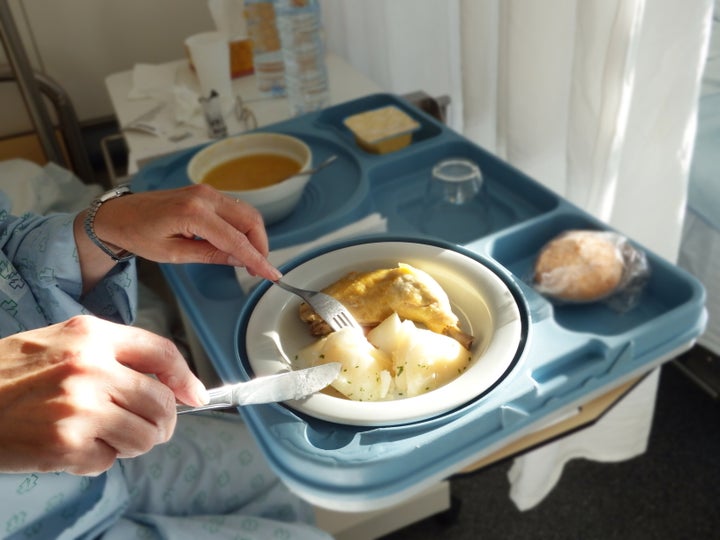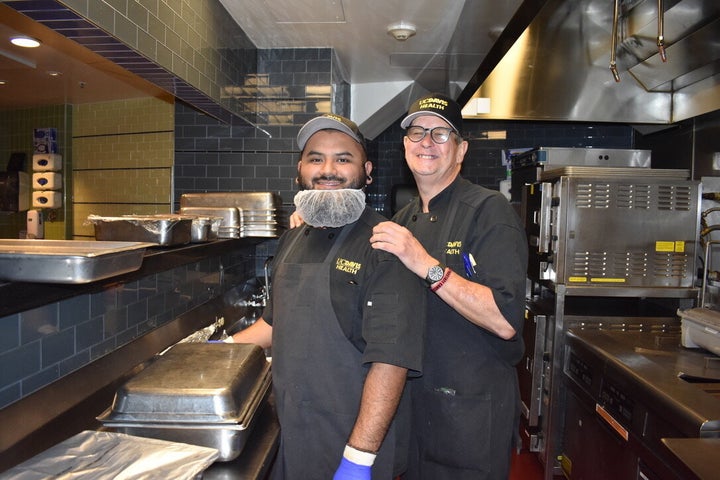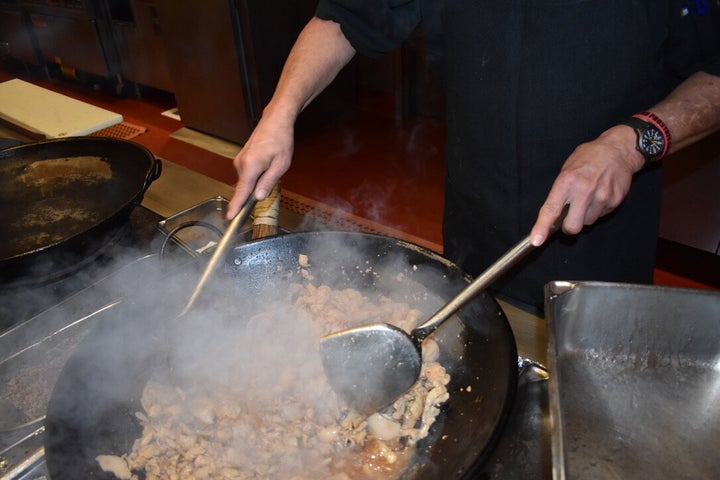SACRAMENTO, Calif. — The terrible food in hospitals has long been one of the greatest contradictions in health care. Over the past few years, several doctors have spoken out about the lack of healthy food options and how frustrating it can be to tell their patients to make dietary changes, only to have that guidance undermined by the very hospital treating their patients.
But now, some hospitals are taking note.
Across the country, medical centers are hiring executive chefs, working closely with nutritionists and dietitians, and striving to ensure that patients with a wide range of dietary needs and restrictions are getting not only the nourishment they need while in the hospital, but the information they need to keep from coming back.
“It is embarrassing in this era of nutritional knowledge and disease prevention that any hospital not offer a range of healthy food options during recovery,” said Dr. Eric Rimm, director of the cardiovascular epidemiology program at Harvard T.H. Chan School of Public Health.
Hospital malnutrition affects 30-50% of patients worldwide, according to a September 2019 study published in the Journal of Parenteral and Enteral Nutrition. “Often patients enter the hospital malnourished or at risk of malnutrition and experience nutrition decline during their stay, placing them at higher risk for adverse outcomes following hospital discharge,” the study says.
And while the issue of malnutrition in hospitals has been a concern in the United States since the 1970s, it hasn’t been studied widely enough to make formal recommendations. But according to the researchers, approximately 1 in 3 patients in the U.S. are at risk of malnutrition.
An increased risk of malnutrition “often leads to poorer outcomes for both the patient and the healthcare system,” states the study, concluding that “patients who have diminished meal intake experience increased mortality risk.”

Hospitals are already overwhelmed by constrained budgets and competing needs, and now they are also scrambling to cope with the rapidly unfolding coronavirus outbreak. So for some, providing their patients, staff and visitors with healthier food is one way they can ensure a better overall experience during trying times.
Plus, Rimm said, it’s “such a great opportunity” for doctors to teach their patients about eating healthier in their daily lives. This can hopefully reduce or even eliminate diet-based health risks like heart attacks, diabetes, obesity and more. “The message and delivery of a healthy diet starts in the hospital during early recovery,” said Rimm, “in the same way you would expect for physical rehab after a heart attack.”
And it all begins in the hospital’s kitchen.
A number of hospitals in the U.S. are redesigning their food programs for staff, patients and visitors alike, ranging from in-room, patient-centered menus and healthier options in the cafeteria, to more catering options for events like new-hire orientations, graduations and board meetings. The hope is that healthier food will make hospitals more competitive for recruiting top talent, cut down on staff health care costs associated with unhealthy diets, and enhance patient well-being and recovery.
“We’re changing the stigma of hospital food as frozen, bland, not fresh. It’s challenging but incredibly rewarding.”
- Jet Aquirre, executive sous chef at UC Davis
At the University of Wisconsin Health, patients can order fresh, made-on-demand meals like Asian chicken salad, flatbread pizza or a roast beef sandwich if it’s within a patient’s diet profile. In-room service also extends to people visiting a patient who isn’t able to leave their room to eat.
Meanwhile, MaineHealth, the largest health care provider in the Pine Tree State, has redesigned its cafes to downplay desserts, emphasize fruit and vegetable options on daily menu boards, and prioritize water over sugary drinks.
And some, like UC Davis Medical Center, are taking it one step further.
Two years ago, the hospital, part of the University of California system, hired executive chef Santana Diaz, who had previously served as the founding executive chef at the Golden 1 Center, a sports arena and concert venue in downtown Sacramento.
Diaz was committed to bringing the Sacramento area’s famed Farm to Fork philosophy to the UC Davis food program, which meets a wide range of dietary needs, including for people with heart problems or diabetes. This meant overhauling every aspect of the program, from purchasing to waste, to ensure the entire program was healthy, sustainable and regionally sourced.
Diaz has attempted to keep the overall costs of the new program nearly the same as before by replacing disposable plastic cutlery with reusable flatware, by hiring full-time staff instead of relying on hourly employees subject to overtime, and by leveraging the hospital’s buying power as one of the largest purchasers in the area. While the changes cost a little more at the beginning of the program, long-term, he’s hoping he can prove that healthier food served on a more convenient schedule will also result in less food waste, saving the hospital even more money.
“Keep in mind, if it was easy, everybody would do it. It’s not easy,” Diaz said. “If it was cheap, everyone would do it as well. It’s not cheap. We need to go in knowing that it’s going to cost more.”

The goal, Diaz said during a tour of the facilities at UC Davis, is to rethink “that plate of food that the patient is receiving, which is colorless, and maybe a little bland, and the only color on the tray is a cup of Jell-O, and maybe it’s delivered at times when they’re not in their room because they’re getting a test, or they’re not hungry because of chemo, or because they just received some bad news.”
Instead, he said, health facilities should ask, “Is it possible that we can source some cool food locally, still adhere to the 38 different diets that we adhere to for patient care, maybe present it more colorfully, at more convenient times, and have it taste like something so they actually consume it and receive the nutrients the hospital is trying to give them?”
In the two years since Diaz joined UC Davis, the hospital meal program has grown, now serving 71,000 meals a day to patients, staff, residents and even locals who come in to dine in the renowned cafe. It’s the only hospital cafe in the nation to be awarded the prestigious James Beard Foundation Smart Catch Leader designation, which recognizes dining establishments serving seafood caught and prepared with environmentally responsible methods.
“We’re changing the stigma of hospital food as frozen, bland, not fresh,” Jet Aquirre, executive sous chef, told HuffPost. “It’s challenging but incredibly rewarding.”
And patients have taken note. Diaz said he and his team have received personal thanks from staff, patients and visitors.
But Diaz and his team aren’t operating in a vacuum. “We are not some rogue entity,” he said. Although Diaz is only making these changes at UC Davis right now, he’s hoping his program will ultimately serve as a pilot for all 19 hospitals and health care facilities in the UC system. “When we look at the system as a whole, can we show that this can work?”

How to prioritize healthy food is a question that chef Christopher Dickens at Southeast Health in Alabama is also asking as the hospital and the food facilities go through a ground-up renovation that’s putting healthier options at the forefront.
“Our patients can’t choose where they are, how they feel. They just don’t have a lot of choice,” Dickens told HuffPost. “If we don’t do everything in our power to make sure that’s a great experience, then shame on us.”
He explained that the hospital is trying to move away from processed foods, refined sugars and excess oil “so that we can produce a product that truly helps our patient, and our community and our staff, with overall health.”
“We’re very fortunate to be so close to the coast, and be able to bring in a lot of fresh seafood, a lot of organic products, from grass-fed beef to hormone-free and antibiotic-free poultry from a facility less than a mile from us,” Dickens continued. “People have their preconceived notions of what hospital food is, and we want to break those.”
“We know that food is medicine,” said Dickens, “and we need to be ahead of the curve.”
“Our patients can’t choose where they are, how they feel. They just don’t have a lot of choice. If we don’t do everything in our power to make sure that’s a great experience, then shame on us.”
- Christopher Dickens, chef at Southeast Health in Alabama
Ultimately, it’s all about trust and helping improve patients’ diets even once they’ve left the hospital, Diaz said. “If you can trust where our food comes from, and you trust that what we’re creating out of our kitchen tastes great, then you can trust that down the road you can eat a little healthier because you’ve been shown and educated that good food, healthy food actually tastes good.”
At both UC Davis and Southeast Health, teams work with dieticians and nutritionists during the meal planning process in-house as well as engaging in community outreach through local farmers markets or cooking classes targeted toward people with medical conditions like high blood pressure or diabetes.
Neither hospital has completely overhauled its system yet ― Southeast Health has an on-site Chick-fil-A with a restricted menu, and UC Davis still has some unhealthier options in its grab-and-go cafe, like chips and desserts ― but it’s an ongoing process.
“It’s going to take some training, and it’s going to take more labor,” said Diaz. “but the end goal could be huge.”
For more content and to be part of the “This New World” community, follow our Facebook page.
HuffPost’s “This New World” series is funded by Partners for a New Economy and the Kendeda Fund. All content is editorially independent, with no influence or input from the foundations. If you have an idea or tip for the editorial series, send an email to thisnewworld@huffpost.com.